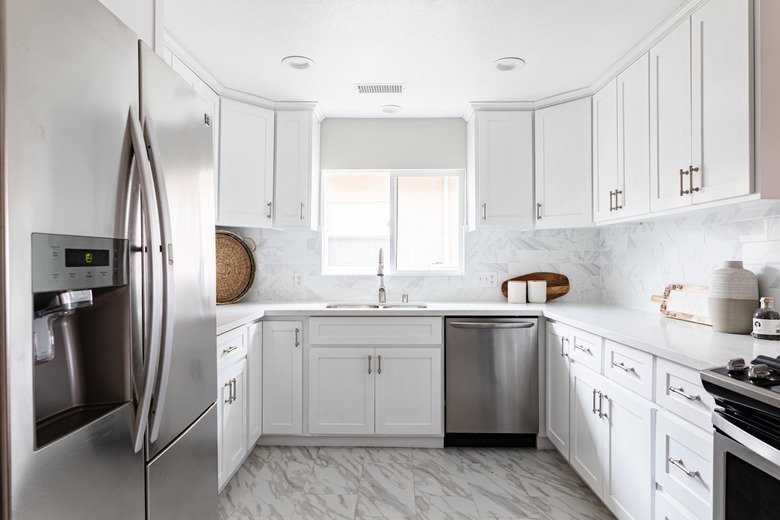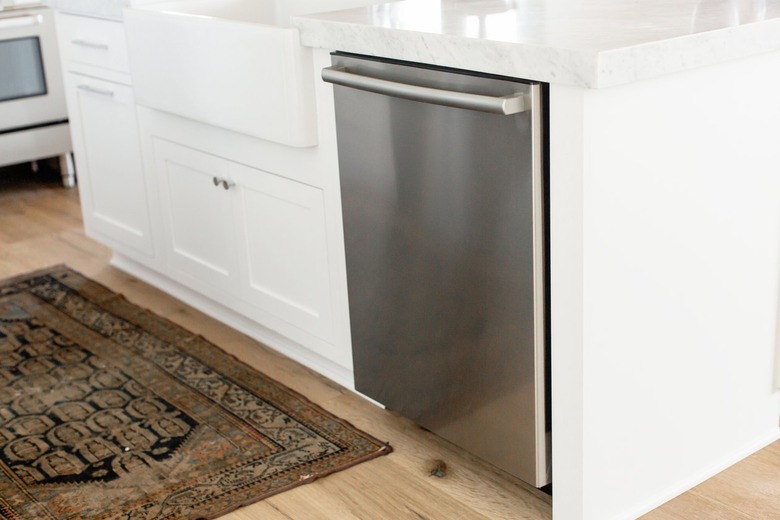A Homeowner's Guide To Kitchen Outlets
We may receive a commission on purchases made from links.
What makes a kitchen functional: the sink, the stove, the refrigerator? Sure, all of these things play an important role, but in today's kitchens, full of portable and power-hungry appliances, it's arguably the kitchen outlets that add the most function of all. Kitchen outlets, technically called receptacles, provide power for our coffee makers, blenders, juicers, toasters, waffle irons, mixers and even smart speakers (Alexa, can you cook something for me?). They also supply electricity for many large appliances, like refrigerators and freestanding ranges.
With their critical contribution to kitchen productivity, it's no surprise that kitchen outlets come with a lot of electrical code rules, which can change as often as every three years. These are outlined in the National Electrical Code (NEC) and are enforced by your local code authority (typically your city's building department). So, before you plan your kitchen remodel or electrical upgrade, it pays to learn the basics of kitchen outlets and the specific requirements of the local code (most follow the same standards set by the NEC).
GFCI and AFCI Protection for Kitchen Outlets
GFCI and AFCI Protection for Kitchen Outlets
Kitchens are wet places, and as you probably know, water and electricity make fast friends. That can spell danger for someone plugging in an appliance with a wet hand. For this reason, the NEC requires that all receptacles serving countertop areas have GFCI (ground-fault circuit-interrupter) protection. You also need GFCI protection for any receptacles within 6 feet of a sink.
Older code rules may have permitted non-GFCI outlets inside a cabinet or behind the fridge next to a sink, but that is no longer the case. The 6-foot rule applies no matter where the outlet is located. In addition, if a dishwasher is wired with a cord and plug, the outlet it plugs into must be a GFCI.
AFCI (arc-fault circuit-interrupter) protection applies to all 120-volt circuits in the kitchen. This protects against the risk of arc faults leading to fires. Because all of the GFCI circuits in the kitchen are 120-volt, all of the GFCI circuits also need AFCI protection. There are multiple methods for providing AFCI and GFCI protection, but the simplest solution is to use dual-function AFCI/GFCI circuit breakers.
Kitchen Countertop Outlets
Kitchen Countertop Outlets
Nothing has modernized the kitchen more than the NEC guidelines for the outlets serving the countertop areas. While kitchens from the 1960s and earlier may have had enough outlets for just a few appliances, today's kitchens have at least two 20-amp circuits (called small-appliance circuits) primarily devoted to the countertop receptacles, and almost no space on the counter is more than 24 inches from an outlet.
There are basic placement guidelines for countertop outlets, and most rules apply to the wall area above the countertops:
- All countertop spaces 12 inches or wider must have a
receptacle. - Receptacles over a continuous countertop area can be placed
no more than 48 inches apart. - A receptacle is required within 24 inches at each side of a
typical sink or range. There are special rules for sinks and ranges that sit at
least 18 inches or 12 inches, respectively, from the back wall. - Islands and peninsulas (of most sizes) must have at least
one receptacle. These are typically located below the countertop but may be no
more than 12 inches below the countertop surface and may not be below an
overhang deeper than 6 inches. - Receptacles may not be installed face up on countertop
surfaces. - Code-approved pop-up receptacles are allowed and may be used
in place of an island or peninsula below-counter receptacle.
Electric Range Receptacles
Electric Range Receptacles
Electric ranges need an outlet that provides both 120 and 240 volts and 40 to 60 amps of power. It must be supplied by a dedicated circuit, meaning there can be no other appliances or electrical equipment on the same circuit; its one job is to power the range. The dual-voltage requirement is simpler than it sounds. By wiring the circuit to current code standards, you'll supply all the voltage the appliance needs. For the record, the range uses 120 volts for its electronic controls, lights, buzzers, etc., and it needs 240 volts to power the range burners and oven elements.
What's not so simple is the history of electric range cords and outlets. Prior to 1996, the NEC allowed ranges to have three-prong cords that fit three-slot outlets. These had two 120-volt "hot" wires and one neutral wire; there was no separate ground, and the appliance was grounded through the neutral. As of a 1996 code change, all newly installed range outlets must have four slots, including a separate ground slot. Accordingly, the range must be wired with a four-prong plug that has a ground wire. A separate ground path is safer than using the neutral for grounding.
Most range outlets are rated for 50 amps. Depending on the range's wattage rating, it may be permissible to use a 40-amp outlet, but 50 amps is a better standard. Very large ranges may require 60-amp service. Because this is a 240-volt circuit, it is controlled by a double-pole circuit breaker. Range outlets typically are located on the lower portion of the wall directly behind the range. This allows you to reach the outlet by removing the drawer below the range's oven compartment.
Outlets for Refrigerators
Outlets for Refrigerators
All refrigerators plug into a 120-volt receptacle, usually located about halfway up the wall directly behind the fridge. Depending on local code rules, it may be permissible to connect the fridge receptacle to one of the 20-amp small-appliance circuits, but in some areas, the fridge must be on a dedicated circuit, either 15 or 20 amp, depending on code requirements.
If a refrigerator happens to be close to a sink, which is not uncommon in very small kitchens, the outlet into which the fridge plugs must have GFCI protection per the 6-foot rule. The NEC requires a minimum of 15 amps for the refrigerator circuit, but best practices dictate 20 amps for this outlet. A modern energy-efficient refrigerator may use well under 200 watts when running, but its startup demand — the power it uses when the compressor kicks on — might be as high as 1,200 watts or more.
Powering Microwaves and Vent Hoods
Powering Microwaves and Vent Hoods
Microwave ovens have similar requirements to refrigerators. They can be plugged into an outlet on one of the small-appliance circuits, or they can have an outlet on their own dedicated 20-amp circuit. Some microwaves also can be hard-wired, but in this case, they don't use an outlet, of course.
Countertop microwaves usually plug into one of the outlets on the kitchen backsplash area. Over-the-range microwaves, which are typically mounted to the bottom of a wall cabinet, often plug into an outlet located inside the cabinet. The unit's plug runs up through a hole drilled into the cabinet's bottom panel.
Kitchen vent hoods typically are hard-wired to one of the kitchen's 15-amp lighting circuits and therefore do not need a receptacle. Some vent hoods are designed for cord-and-plug connection, or a cord connection is available as an option. As noted by Electrical Contractor, plugging in a vent hood is allowed by the NEC only if the outlet is on a dedicated circuit.
Outlets for the Dishwasher and Garbage Disposer
Outlets for the Dishwasher and Garbage Disposer
Both dishwashers and garbage disposers (or disposals) can be hard-wired, or they can plug into an outlet. Because they're both close to the sink, they often plug into the same receptacle located inside the sink base cabinet. Electricians and local electrical codes differ on the best way to do this. The NEC allows both appliances to be on the same circuit if their combined wattages do not exceed the circuit's capacity, but many kitchens have them on their own dedicated 20-amp circuits. In any case, all dishwasher and disposer circuits must be GFCI-protected.
When a single outlet serves both appliances, it may be "split-wired" so that the disposer half of the outlet is controlled by a switch while the dishwasher half is not, so it's always on. It's also possible to wire a single outlet so that it is fed by two separate circuits — each half has its own 20-amp supply. An important safety requirement with this configuration is to wire both circuits on the same double-pole circuit breaker. This ensures that you cannot shut off the power to one half of the outlet without shutting off the other.



